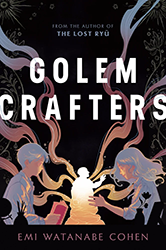The popular image of dragons that many readers hold will be decidedly challenged in Emi Watanabe Cohen’s new middle-grade novel. Instead of the fire-breathing winged beast of western folklore, readers will meet a different breed of the creature. Indeed, in this story of emotional growth, everyone has a ryū, a dragon with unique traits and an indelible role to play as the drama unfolds.
The novel takes place in 1960s Japan, where ten-year-old Kohei Fujiwara is trying to make sense of his damaged family: a father who died, a mother under stress, and an ill, angry grandfather. When an American girl of mixed Japanese and Jewish ancestry moves into their building, he learns that he is not alone in his confusion.
Cohen gradually introduces some of the paradoxes of postwar life in Japan, a country that was defeated by the Allied forces after years of dictatorship under a corrupt fascist government. Much about this ignominious past is left unsaid but implicitly addressed through the often-repeated statement shikata ga nai, or “nothing can be done to change the situation.” But Kohei remembers a father who defied this culture of denial, rather giving his son a message of persistence.
The fantastic element of the plot, including dragons and how to breed them, melds smoothly into the realistic framework of the characters’ dilemmas. Kohei is aware that his grandfather’s distress is related to a lost type of dragon. Meanwhile, the boy’s own personal ryū is small, pink, and sarcastic. So much for the huge, winged menaces of medieval stories!
When Isolde Carter and her family become the tenants of Kohei’s family, he grows suspicious of her overtures towards friendship. Isolde’s dragon introduces more cultural questions. To Kohei’s initial annoyance, the western variety he was excited to encounter actually speaks Yiddish, which an angry Isolde vehemently points out is a “real language.” Japanese and Jewish history, western and eastern dragons, and families divided by difference are some of the novel’s themes, but personal idiosyncrasies necessarily intervene. These subtle surprises keep the novel from veering towards cliché.
There is an abundance of information about Japanese language and culture, including many transliterated phrases that provide a more immediate connection to the characters. By contrast, there is almost no use of Yiddish, despite the promising plot point about Isolde’s dragon. Nevertheless, the author shows great sensitivity to the ways that both children feel torn by their dual identities — a preoccupation that is also reflected in their quest to locate a dragon who will heal Kohei’s grandfather.
There is one jarring moment when Isolde equates, if only implicitly, the unconstitutional internment of Japanese Americans with Nazi extermination camps. The likening is a reminder of how difficult it is to honor all losses without erasing distinctions between them. Emi Watanabe Cohen has created a compelling response to that truth.
Emily Schneider writes about literature, feminism, and culture for Tablet, The Forward, The Horn Book, and other publications, and writes about children’s books on her blog. She has a Ph.D. in Romance Languages and Literatures.




